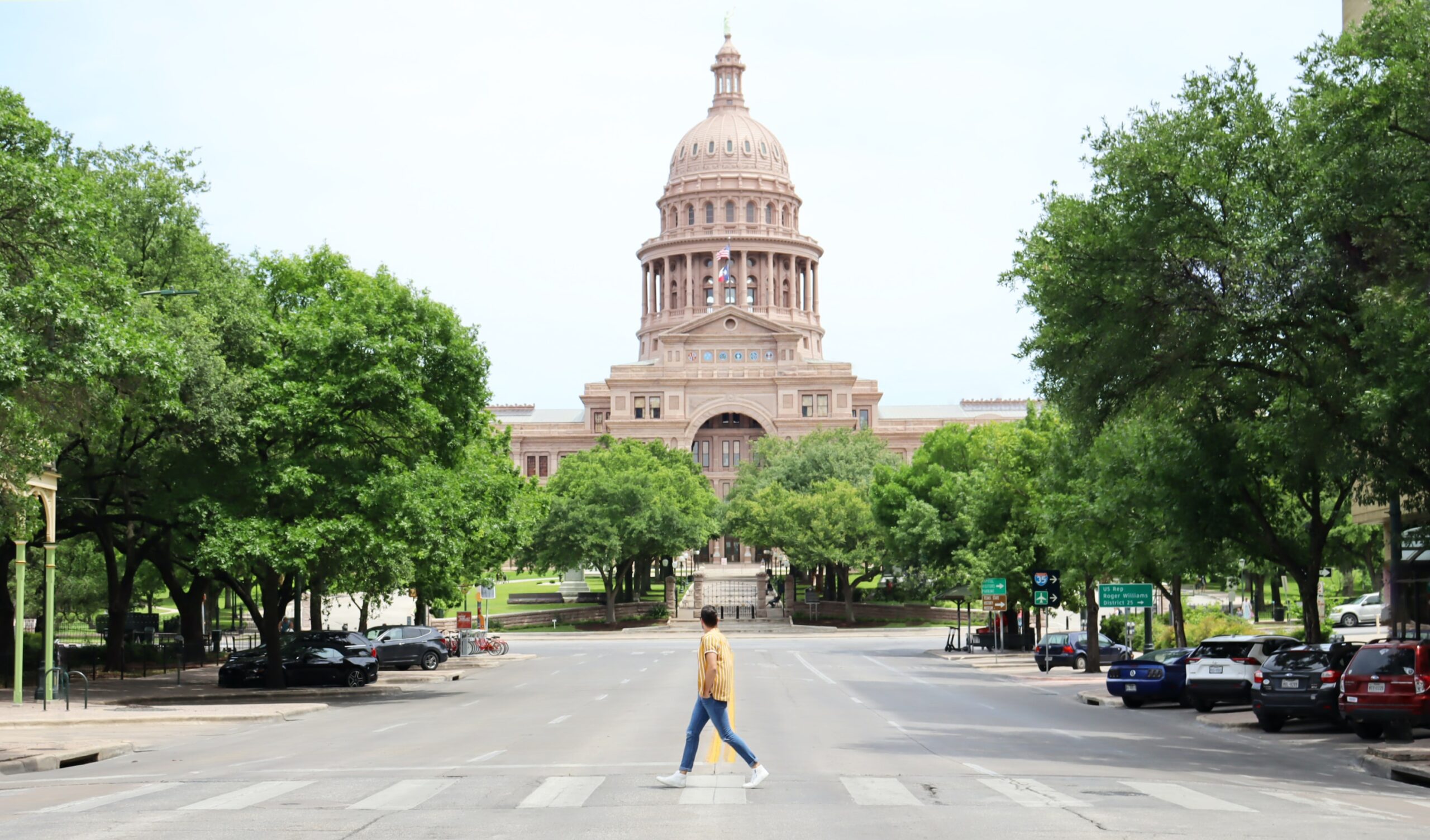
Legislative Session Recap
2021 Legislative Session Recap
The 2021 legislative session saw a wave of state legislation aimed at tackling some of the greatest environmental threats facing our country. Below is a recap of just some of the environmental victories from states this year.
Climate and Energy
Climate and energy legislation seeks to address global climate change through emissions reductions, deployment of clean energy infrastructure, and nature-based solutions. Many states took steps this year to decarbonize parts, if not all, of their economies with emissions reductions targets, carbon pricing, ocean protection, and electrifying transportation.
Emissions Reductions and 100% Clean Energy Targets
To help mitigate the worsening effects of climate change, states across the country continued to introduce legislation to reduce their emissions and transition to 100% clean energy in 2021. A total of 23 states considered legislation to set emissions reduction targets and/or establish standards for their energy portfolios to be made up of specific amounts of clean energy. Massachusetts, Oregon, Rhode Island, and Virginia enacted legislation to set emission reduction targets, while Illinois, North Carolina, and Oregon enacted bills to transition to 100% clean energy. Many states’ bills also included equity considerations alongside measures to decarbonize economies, such as the Illinois bill which aims to expand economic opportunities for disadvantaged communities and people of color in the clean energy sector.

Enacted Emission Reduction and 100% Clean Energy Bills
- Delaware (SB 33) Raises the minimum amount of Delaware’s energy that must come from renewable sources by 2035 to 40%.
- Illinois (SB 2408) Requires the state to reach net-zero emissions by 2045. Includes investments in renewable energy, equitable job opportunities and just transition programs in the clean energy sector, electric vehicle incentives, and much more.
- Massachusetts (S 9) Requires the state to reach net-zero greenhouse gas emissions by 2050 and mandates emissions limits every 5 years.
- North Carolina (HB 951) Mandates that the state Utilities Commission take the steps necessary to reach net-zero carbon emission across electric generating facilities owned or operated by electric public utilities by 2050.
- Oregon (HB 2021) Requires retail electricity providers to reduce emissions associated with electricity sold by 100% below baseline levels by 2050.
- Rhode Island (SB 78) Requires the state to achieve net-zero emissions by 2050, with regular updates to the state’s mitigation plan.
- Virginia (SB 1282) Requires the state to conduct an emissions inventory every four years to achieve the net-zero by 2045 goal set in 2020.
Carbon Pricing
This year more states pursued options to put a price on carbon emissions. A total of 18 states introduced carbon pricing bills, with Washington becoming the second state to pass and enact comprehensive carbon pricing legislation. Connecticut, DC, Massachusetts, and Rhode Island joined the regional Transportation Climate Initiative (TCI), which would create a cap-and-trade market on emissions from transportation fuels.
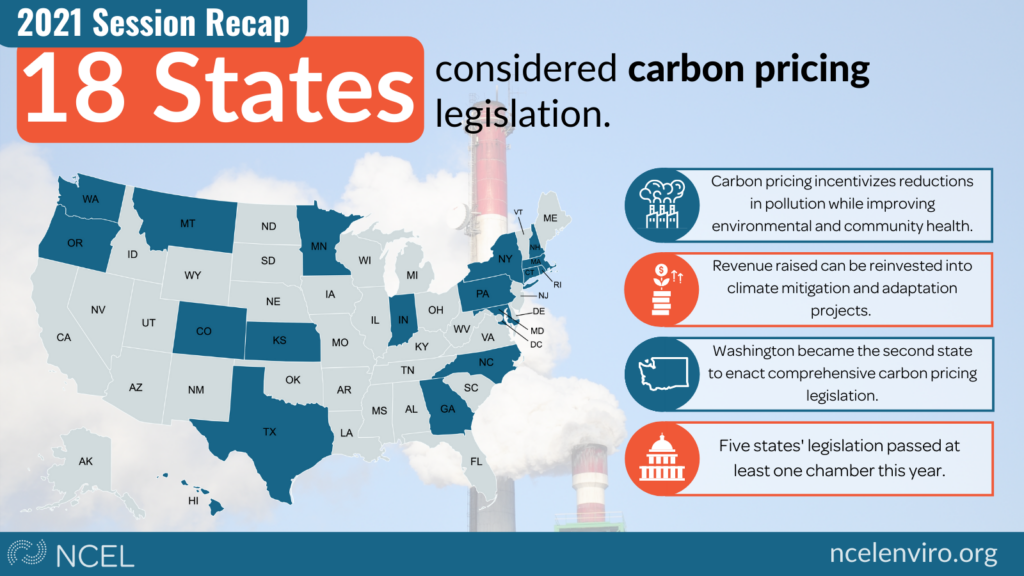
Enacted Carbon Pricing Bills
- Washington (SB 5126) Establishes an economy-wide cap-and-invest program to reduce greenhouse gas emissions. Requires improvement to air quality in communities disproportionately overburdened by pollution.
Oceans
The ocean has been on the frontline of some of the worst effects of climate change, but many coastal states are advancing legislation that would restore coastal areas and uplift oceans as climate solutions. Policy approaches this year included increasing the resilience of coasts, addressing ocean acidification, and transitioning away from offshore drilling to offshore wind energy. Across the 21 coastal states, 27 bills were introduced to expand offshore wind energy, 23 bills to increase coastal resilience, 10 bills to limit offshore drilling, and 6 bills to address ocean acidification.

Enacted Offshore Wind Bills
- Maine (LD 336) Directs the Maine Public Utilities Commission to negotiate long-term power purchase agreement to develop floating offshore wind research array.
- Oregon (HB 3375) Establishes the goal of developing commercial-scale floating offshore wind energy projects within federal waters off the Oregon coast by 2030.
- Virginia (SB 1284) Establishes a policy to expand offshore wind development in state and federal waters while taking into account possible environmental impacts on marine life.
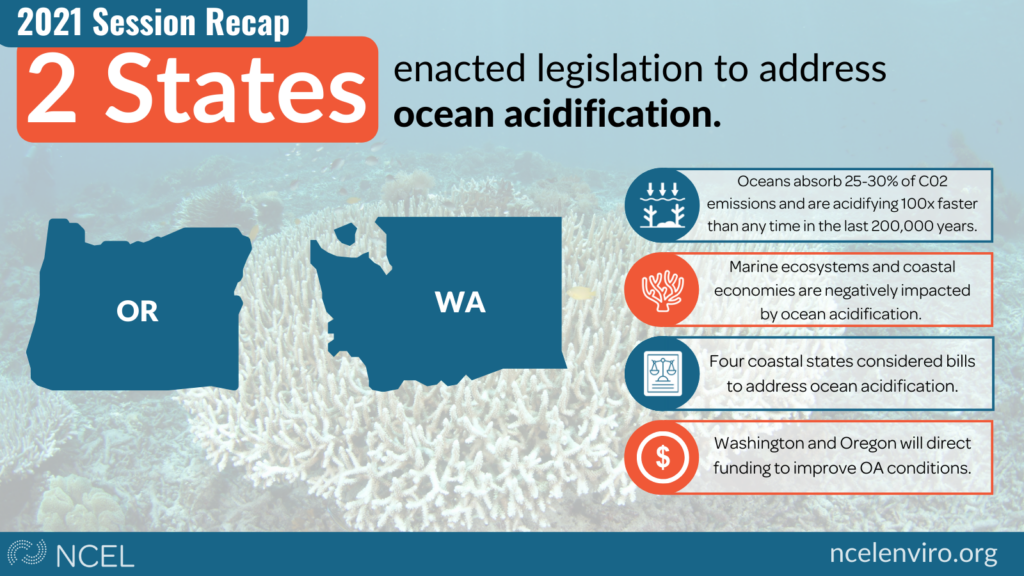
Enacted Ocean Acidification Bills
- Oregon (HB 3114) Allocates funding for projects to monitor and reduce ocean acidification and to revitalize affected marine ecosystems.
- Washington (SB 5126) Allocates funding under the state Climate Investment Account for projects that will help to remediate and adapt to the impacts of ocean acidification.
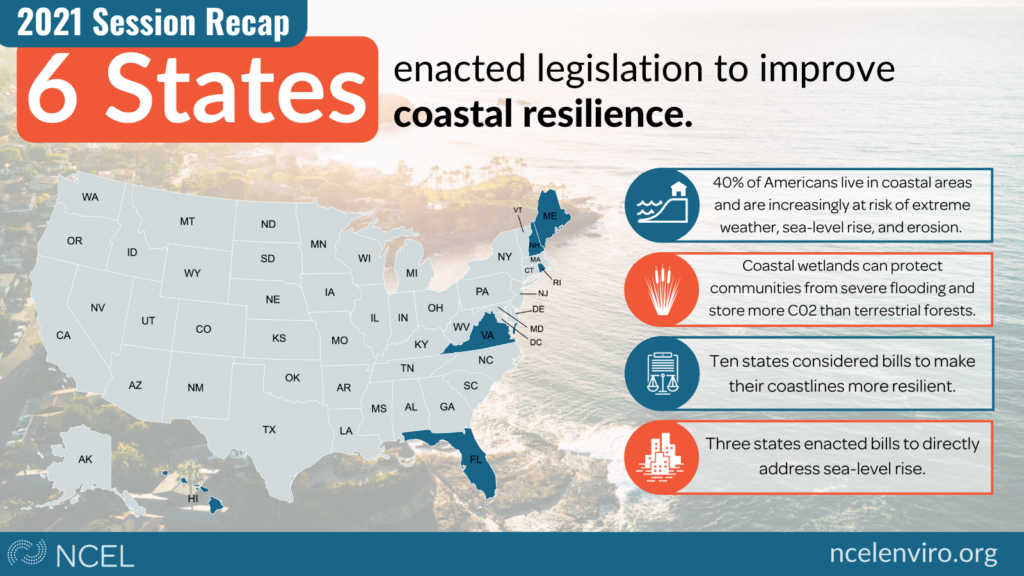
Enacted Coastal Resilience Bills
- Florida (SB 1954) Creates statewide programs to address sea-level rise and flooding across Florida.
- Hawaii (HB 243) Requires the Office of Planning to identify current and future state-owned facilities that are vulnerable to sea-level rise and climate-induced flooding events and to assess options to make the facilities more resilient.
- Maine (LD 1572) Requires agencies to review laws and rules and submit recommendations to incorporate sea-level rise into the administration of them.
- New Hampshire (SB 146) Adopts omnibus legislation that includes establishing a coastal program responsible for protecting and revitalizing natural coastal resources through various initiatives. The bill also establishes a fund for derelict fishing gear and coastal cleanup.
- Rhode Island (SB 35) Establishes the Ocean State Climate Adaptation and Resilience fund as a long-term source of grant funding to allow coastal cities and towns to implement climate resilience projects.
- Virginia (SB 1374) Establishes an intergovernmental task force to study and submit a report on how to use state land and marine resources for carbon sequestration.
Transportation
As the transportation sector is the primary source of emissions in the United States, many state lawmakers are recognizing the role states must play in decarbonizing our transportation. This year 32 states and the District of Columbia introduced at least 124 bills focusing on public transit, expansion of electric vehicle fleets and charging infrastructure, and clean fuel standards. A total of 12 states and the District of Columbia enacted bills to reduce transportation emissions and expand clean transportation technologies.
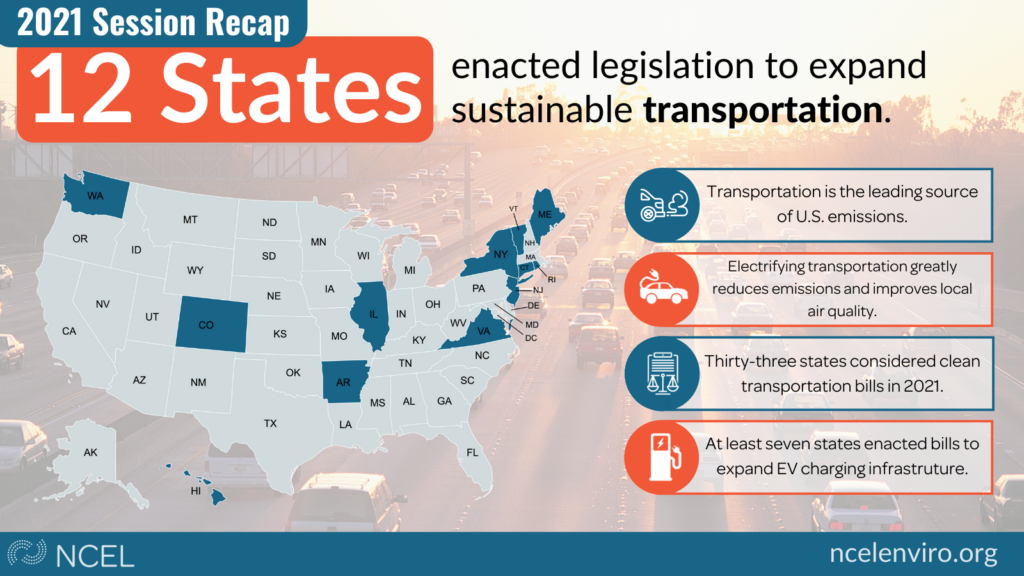
Enacted Transportation Bills
- Arkansas (SB 632) Creates a grant program to fund the construction of electric vehicle charging facilities.
- Colorado (SB 21 260) Provides incentives for, and requests an annual report on, progress on widespread transition to electric vehicles.
- Connecticut (HB 6444) Requires at least 50% of cars and light-duty trucks, and 30% of buses, purchased to be zero-emission vehicles by 2030.
- District of Columbia (PR 24-0334) A resolution to make civil fines for moving and nonmoving infractions of spaces reserved for electric vehicles take effect immediately.
- Hawaii
- (SB 1402) Requires state Department of Transportation to develop and implement plans to create highway and pathway networks for bicycles, pedestrians, and motor vehicles (with preference given to electric vehicles and mass public transit).
- (SCR 89) Urges the University of Hawaii System and Department of Education to include training and courses related to electric vehicles in their respective programs.
- Illinois (SR 0296/HR 0293) Calls for the Governor to sign the Multi-State Medium and Heavy Duty Zero Emission Vehicle MOU calling for 30% of new truck and bus sales to be zero-emission by 2030 and 100% by 2050.
- Maine (LD 347) Directs transmission and distribution utilities to submit a proposed incentive rate schedule to promote the installation of electric vehicle charging stations by November 2021.
- New Jersey
- (A 1653) Encourages development of zero-emission vehicle fueling and charging infrastructure in redevelopment projects
- (S 3223) Establishes that electric vehicle charging infrastructure is inherently beneficial for the public good and general welfare, in addition to making the zoning and application approval for charging infrastructure sites easier.
- New York (A 4302/S 2758) Establishes the goal for all new passenger cars and trucks sold in New York State to be zero-emission by 2035.
- Rhode Island (HB 5031/SB 994) Requires the Department of Transportation to develop a plan by January 2022 for making electric vehicle charging infrastructure more accessible to the public.
- Vermont
- (S 47) Amends state law to allow non-franchised zero-emission vehicle manufacturers to sell vehicles or provide related services in the state.
- (H 433) Includes funding for low-carbon transportation like public transit and rail programs, park and rides, bicycle and pedestrian facilities, and electric vehicle infrastructure.
- Virginia
- Washington
Conservation
In 2021, states across the country introduced conservation bills to address the massive loss of wildlife and biodiversity, and to protect and restore the country’s diversity of ecosystems. Throughout the pandemic, the importance of time outside and access to outdoor spaces was clear. As a result, many states advanced outdoor engagement bills to help ensure outdoor access for all this year. Looking ahead, states are poised to continue advancing wildlife, habitat connectivity, and land conservation bills to stem the rapid loss of nature.
Wildlife
As wildlife population numbers continue to dwindle at alarming rates, states took key steps to conserve and protect wildlife through varied policy approaches in 2021. This session, states introduced legislation aimed at expanding protections for pollinator species, improving habitat connectivity through the use of wildlife corridors on major roadways, and increasing restrictions on wildlife trafficking. In the midst of the COVID-19 pandemic, renewed legislative attention is also being paid to curbing the spread of wildlife diseases which are spreading more easily due to loopholes and lack of regulation in the wildlife and pet trades.
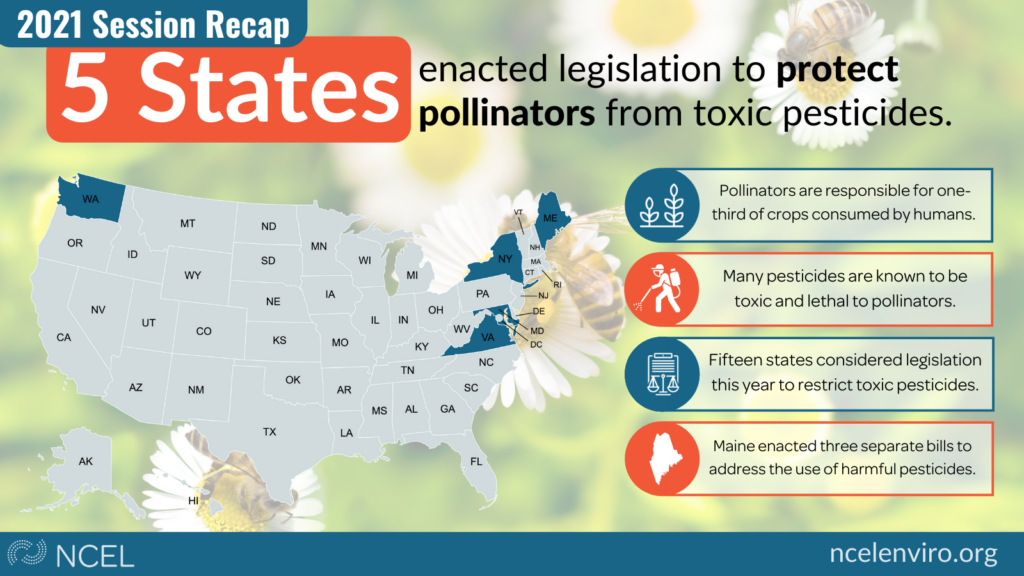
Enacted Pollinator Bills (Pesticides Restrictions/Regulations)
- Maine
- (LD 155) Directs the state Board of Pesticides Control to ban certain neonicotinoid insecticides from being used on residential landscapes.
- (LD 316) Prohibits the use of pesticides containing chlorpyrifos as an active ingredient starting in 2022
- (LD 519) Prohibits the use of the herbicides glyphosate and dicamba within 75 feet of school grounds.
- Maryland (HB 208) Restricts the circumstances in which neonicotinoid insecticides can be sold.
- New York (SB 899) Prohibits the use of glyphosates on state property except for specific circumstances.
- Virginia (HB 2030) Directs the state to study ways to reduce the risk for pollinators from neonicotinoids.
- Washington (SB 5253) Provides funding to implement recommendations made by the Pollinator Task Force, including the adoption of pesticide use that will have minimal impacts on pollinator health
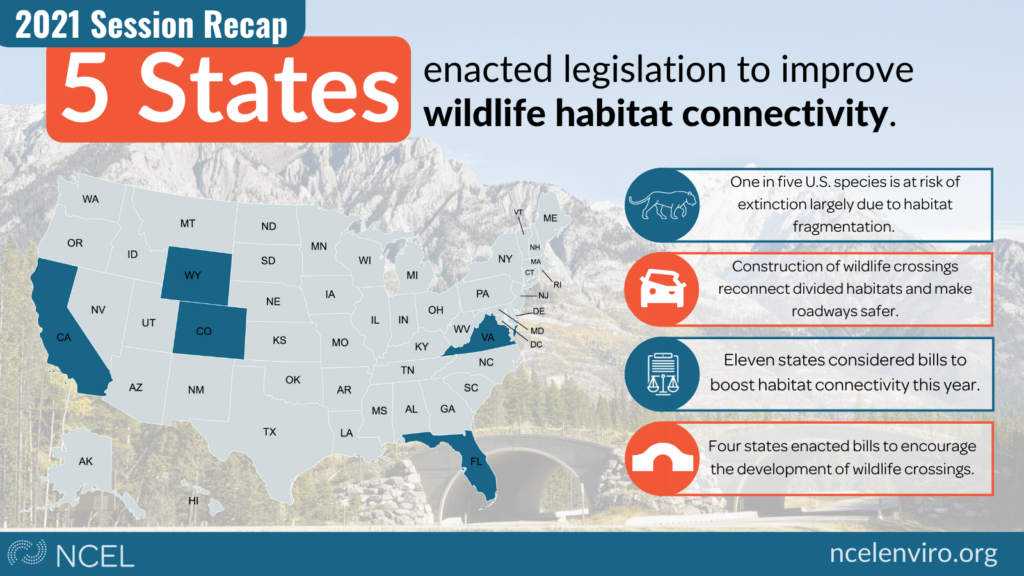
Enacted Wildlife Corridors and Habitat Connectivity Bills
- California
- (AB 149) Authorizes the state Wildlife Conservation Board to name a non-vehicular wildlife crossing if at least 25% of the funding came from a state source.
- (SB 790) Provides that wildlife connectivity actions can qualify for mitigation credit where mitigation is required under state, local or federal law.
- Colorado (SJR 21-021) Recommends a working group of government agencies and various private stakeholders to develop policy proposals that will protect wildlife corridors and encourages the collection of relevant habitat connectivity data.
- Florida (SB 976) Formally recognizes the Florida Wildlife Corridor – an 18 million acre area of land vital to the state’s green infrastructure and wildlife habitat connectivity – and establishes various goals to conserve it, including the implementation of wildlife crossings
- Virginia (SB 1274) Directs various agencies to consider and incorporate wildlife corridors and recommendations from the state Wildlife Corridor Action Plan when developing any governmental strategic plan, map, or action.
- Wyoming (HB 66) Appropriates approximately $2 million for the funding of large wildlife crossing projects.
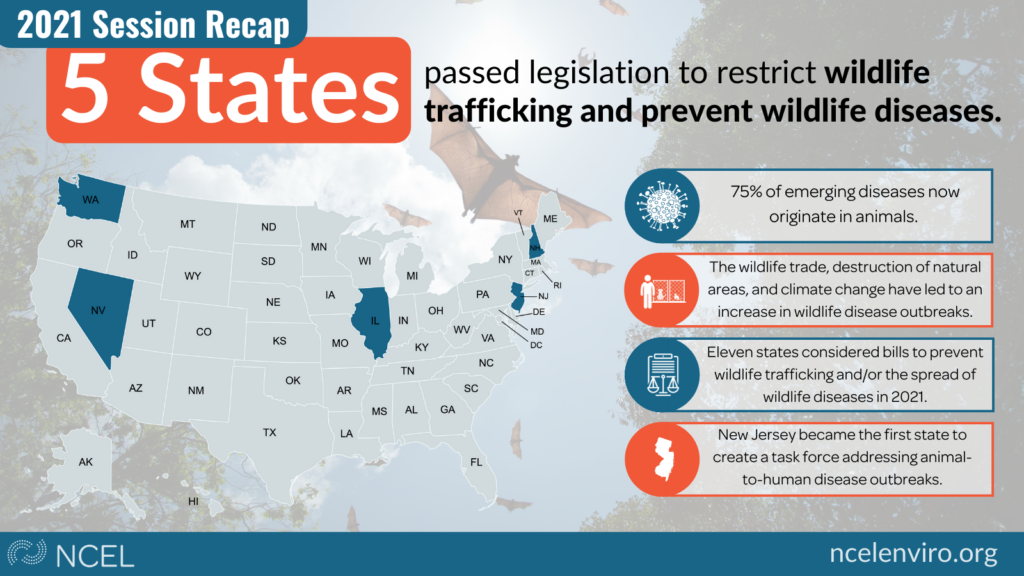
Passed Wildlife Trafficking and Wildlife Disease Bills
- Illinois (HB 395) Amends the Ivory Ban Act to add 16 exotic species banned from wildlife trafficking.
- Nevada (SB 344) Prohibits owners of a “dangerous wild animal,” as defined in the legislation, from allowing the animal to come into contact with members of the public.
- New Hampshire (SB 146) Requires the Fish and Game Department to review and report to the legislature on species that carry zoonotic disease.
- New Jersey (S 347) Establishes the “New Jersey One Health Task Force” to promote interdisciplinary communication and collaboration between physicians, veterinarians and other scientific professionals/state agencies.
- Washington (SB 5092) Appropriates $1 million to establish a Center for Environmental Forensic Science at the University of Washington which will develop, and implement new methods to detect illegal wildlife imports as well as wildlife carrying disease.
Outdoor Engagement
The countless mental and physical health benefits provided by time outside were made even more evident as record numbers of Americans took to the outdoors during the pandemic. This year, 30 states introduced legislation to increase access to outdoor recreation, with 11 states enacting bills and resolutions. Several states’ bills placed an emphasis on equity, demonstrating increasing awareness of outdoor access as an environmental justice issue.
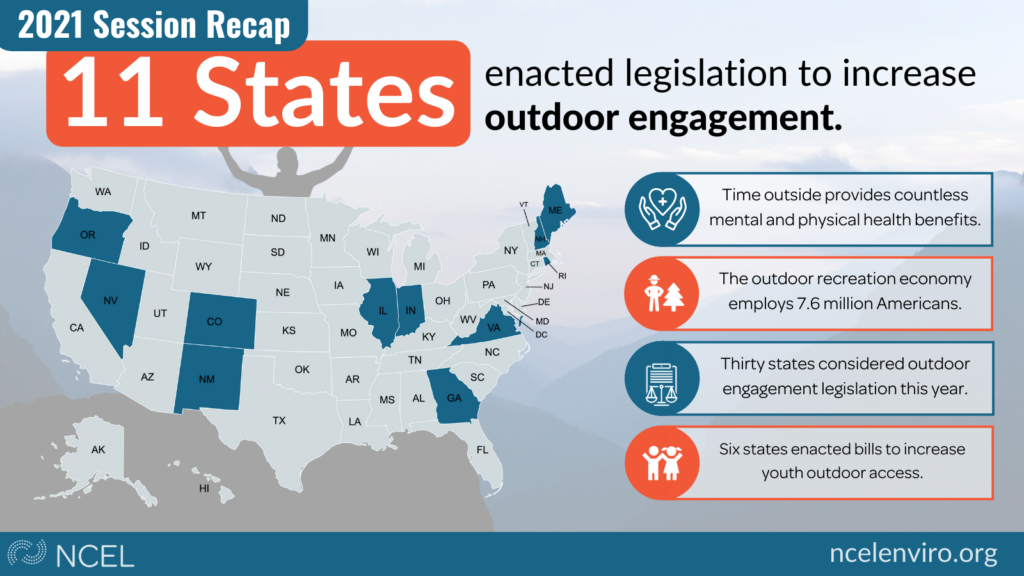
Enacted Outdoor Engagement Bills
- Colorado
- (HB 21-1318) Creates an Outdoor Equity Grant Program intended to increase access to the outdoors for underserved youth and their families.
- (HB 21-1326) Appropriates $1 million to fund the newly created Outdoor Equity Grant Program and $17.5 million to the Parks and Outdoor Recreation Fund for staffing, maintenance, infrastructure and development of state parks.
- Georgia (SR 203) Establishes an Outdoor Learning Committee to look at issues and needs associated with outdoor learning.
- Illinois (HR 0011) Maintains that every child should have the right and opportunity to take part in outdoor recreation.
- Indiana (HR 3) Designates 2021 as “Indiana’s Year of the Trails” and encourages residents to take advantage of and maintain the state’s trail system.
- Maine (LD 1474) Creates pathways for public and private schools to responsibly conduct overnight camping trip.
- New Hampshire (SB 148) Adds environmental education skills, environmental science, and outdoor recreation to the education criteria for the state, while including areas for environmental education in new construction. The bill also establishes a New Hampshire Youth Outdoor Education and Conservation Council.
- New Mexico (SM 1) Convenes a task force to expand the use of outdoor classrooms for the state’s schools.
- Nevada
- (SB 43) Expands the membership of the state Advisory Board on Outdoor Recreation which advises on all matters concerning in-state outdoor recreation.
- (SB 52) Requires the Administrator of the Division of Outdoor Recreation to establish a program for awarding areas that minimize light pollution through different outdoor lighting techniques.
- Oregon
- (SB 289) Bars those convicted of bias crimes on state waters or publically owned outdoor recreation land from reentering those spaces for up to five years.
- (HB 2171) Instructs the Office of Outdoor Recreation to study and make recommendations for legislation that will increase outdoor recreation opportunities, and the State Parks and Recreation Department to establish statewide standards for recreation areas to be made more accessible to Oregonians of all mobility levels.
- Rhode Island (HB 5259/SB 172) Creates a voluntary mechanism for towns and cities to convert land they own into public outdoor recreation spaces.
- Virginia (SB 1290) Creates a data-driven geographical model to identify potential conservation areas that would provide benefits to Virginia residents.
Green Amendments
Green Amendments guarantee citizens the constitutional right to a clean and healthy environment. Eleven states introduced Green Amendment legislation in 2021. New York’s Green Amendment passed the legislature for the second time and the public will vote in November on whether to adopt the constitutional amendment. If enacted, New York would join Montana and Pennsylvania as the only states to currently guarantee citizens the right to a healthy environment, clean air and water.
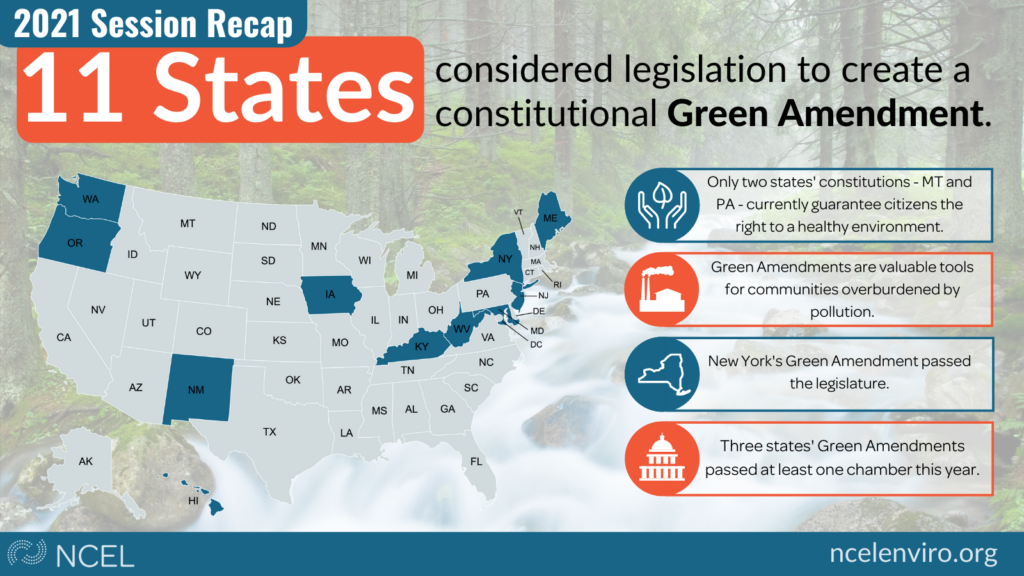
Passed Green Amendment Bills
- New York (S 528) – Would amend the state constitution to guarantee each citizen the right to clean air and water and a healthful environment.
30×30
Earlier this year, 103 legislators joined over 450 officials from 43 states in signing a letter encouraging the federal government to adopt the goal of protecting 30% of the United States’ land, water, and oceans by 2030. State and local support led to the Biden Administration signing an executive order to conserve 30% of American land and water by 2030 to help avoid catastrophic biodiversity loss and the worsening effects of climate change. A key component of reaching this goal is having states adopt their own 30×30 conservation goals. Six states have introduced 30×30 legislation this year, five of which progressed their bills through the legislature.
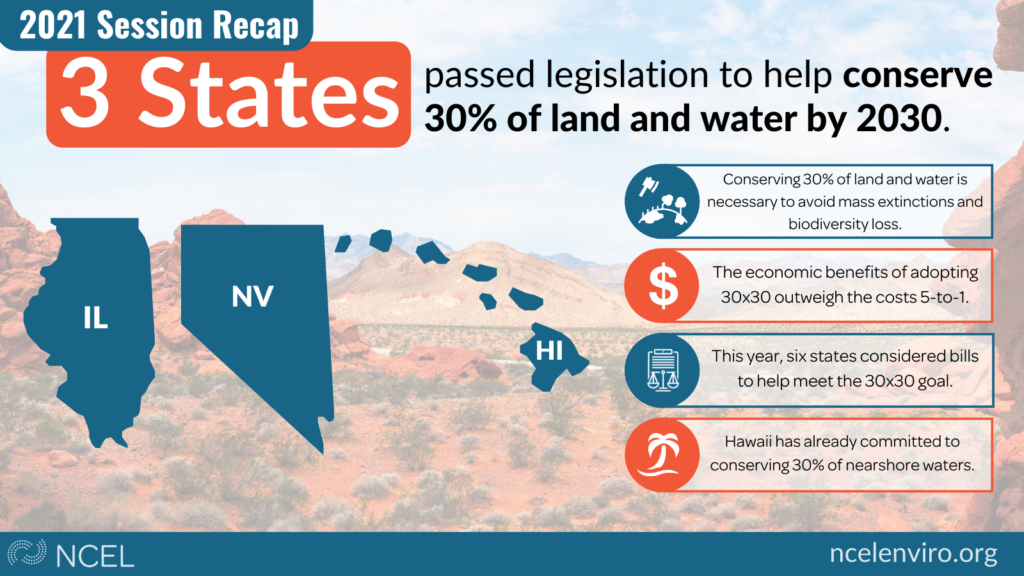
Passed 30×30 Bills
- Hawaii (HB 1019/SB 1173) – Establishes the Ocean Stewardship Special Fund to finance marine conservation and restoration projects, helping to meet the state’s 30×30 management process.
- Status: Enacted
- Illinois (HB 3928) – Would establish a 23 member task force to identify ways of reaching an in-state 30×30 target.
- Status: Sent to Governor
- Nevada (AJR 3) – Expresses the state legislature’s support for a statewide 30×30 goal.
- Status: Passed Second Chamber
Environmental Health
Environmental Health legislation addresses the intersection of environmental degradation and public health. States are working to incorporate equity and environmental justice into legislation as many environmental health disparities fall on communities relegated into marginalized positions due to systemic inequities, namely black, brown, indigenous, and other communities of color and lower socio-economic status. In 2021, states continued to take steps to address these environmental injustices alongside efforts to reduce waste, pollution, and exposure to toxic chemicals.
Zero-Waste
Following an active year for zero-waste legislation in 2020, states throughout the country continued the momentum in 2021 by introducing bills with varied approaches to limiting plastic pollution and other waste products. Earlier this year, state legislators from nine states launched a coordinated effort to progress Extended Producer Responsibility (EPR) legislation which would hold plastic producers responsible for the waste they create. In total, 184 zero-waste bills were introduced across 35 states and the District of Columbia. Washington enacted a comprehensive bill that addresses waste reductions and improves recyclability of materials, while Maine and Oregon became the first states to enact EPR for packaging bills.
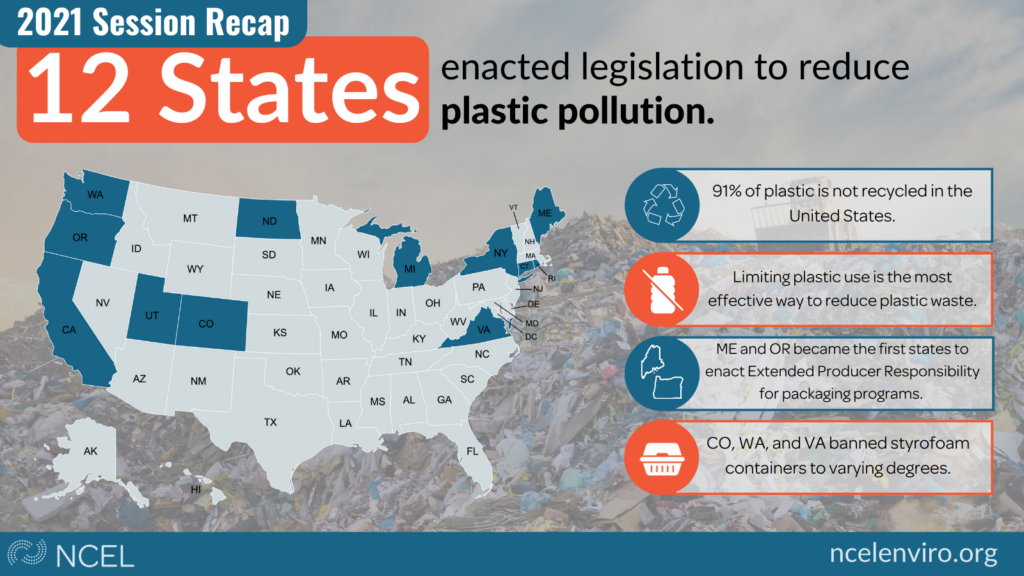
Enacted Zero-Waste Bills
Source Reduction: Single-use Bans and Fees
- Colorado (HB 21-1162) Requires retailers to impose at least a ten-cent fee for carryout bags, requires all carryout bags to be made of recycled paper by 2022, and bans food retailers from using expanded polystyrene takeout containers.
- District of Columbia (B 23 0506) Among other things, the bill requires a uniform recycling labeling scheme, additional standards regarding the use of compostable food service ware such as requiring the use of reusable food service ware when providing food for consumption, establishes a reuse and donation program to reduce waste in landfills and incinerators, and makes grants available to support reductions in the use of disposable food service ware as well as for food waste programs and to encourage share tables at public and charter schools.
- Rhode Island (HB 5131/SB 155) Prohibits food service establishments from providing single-use plastic straws unless requested by a customer.
- Utah (HCR 9) Encourages various state agencies to work with local experts and stakeholders to explore the creation of a statewide anti-littering campaign.
- Virginia (HB 1902) Prohibits the use of styrofoam containers for all food vendors by 2025.
Extended Producer Responsibility for Packaging
- Maine (LD 1541) Creates an EPR program for packaging materials.
- New York (R 504) Advances a proposal to implement EPR requirements for paper and packaging products.
- Oregon (SB 582) Creates a statewide EPR for packaging program and a list of accepted recyclable materials meant to standardize in-state recycling.
Bottle Bills
- California (AB 938) Recognizes that the loosening of requirements for beverage container redemption centers during COVID-19 has resulted in a 30% drop in reclaimed beverage containers and establishes that money collected for administrative penalties under the act be appropriated towards increasing the recycling of plastic beverage containers.
- Connecticut (SB 1037) Requires every beverage container (carbonated and noncarbonated) to have a clearly stated refund value that is no less than five cents, with some exceptions.
Recycled Content
- Connecticut (SB 928) Directs the Commissioner of Energy and Environmental Protection to consult with various waste management stakeholders and submit recommendations for developing recycled content requirements.
- Michigan (HB 4015) Makes it unlawful for a manufacturer to market a product in a way that misrepresents the amount or type of recycled content in a product, consistent with the Federal Trade Commission’s guides on environmental marketing claims (16 CFR part 260).
- North Dakota (HB 1015) Establishes that when practical, any state agency or institution should specify paper and paper products containing at least 25% recycled materials.
- Oregon (HB 2395) Requires all paper check-out bags to contain at least 40% post-consumer recycled fiber and/or nonwood renewable fiber.
- Utah (SJR 10) Reaffirms the goal of the Salt Lake City International Airport to source local materials containing recycled content.
- Virginia (HB 1986/SB 1204) Establishes a preference for contractors of George Mason University whose goods contain higher amounts of recycled content if all other categories are equal.
- Washington
- (SB 5022/HB 1118) Creates a minimum recycled content standard for plastic beverage containers, household cleaning and personal care bottles/jugs and trash bags. Prohibits the sale and distribution of styrofoam foodservice products, coolers, and packaging peanuts. It also makes plastic serviceware (e.g. straws, utensils) available upon request of customers.
- (HB 1192) Requires recycled content paper carryout bags to be made with at least 40% recycled content and film plastic bags to be made with at least 20%.
- (HB 1145) Allows for the use of nonwood renewable fiber in paper carryout bags containing recycled content.
Cumulative Impacts and Environmental Justice
More states are focusing on the cumulative impacts of environmental threats and the disproportionate burden of these exposures felt by black, brown, indigenous, and other communities of color and lower socioeconomic status. State legislators are working to improve the health of communities and avoid continued exposure to hazardous substances. A total of 40 bills were introduced across 12 states to address the cumulative impacts of pollution this year.
Due to the high volume of environmental justice bills introduced this session, a brief selection of legislation is included below. A full list of successful environmental justice legislation from the 2021 session can be found here.
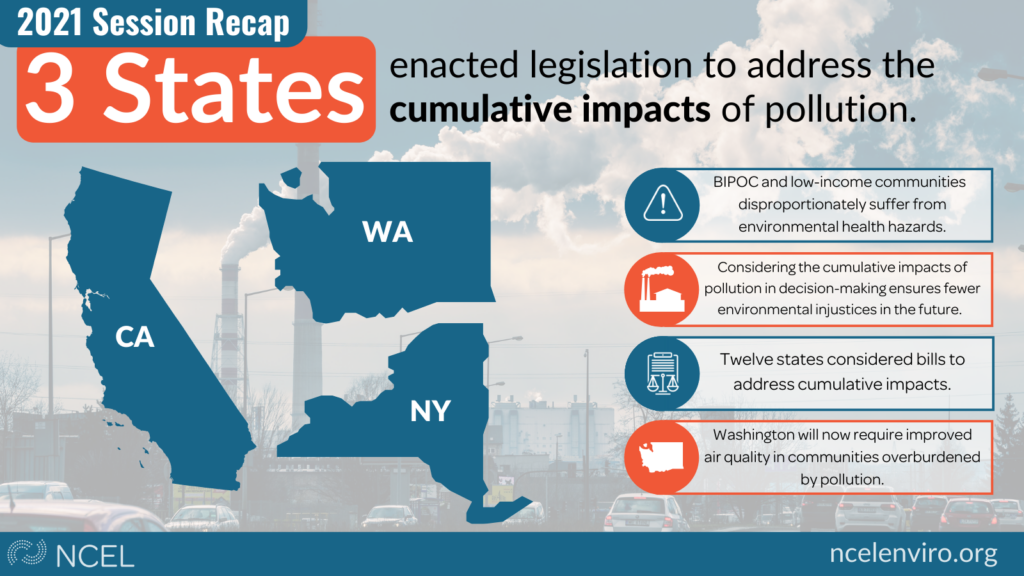
A Selection of Environmental Justice Bills
- Colorado (HB21-1266) Defines “disproportionately impacted community” and requires the air quality control commission to promote outreach to and engage with disproportionately impacted communities by creating new ways to gather input from communities across the state, using multiple languages and multiple formats, and transparently sharing information about adverse effects resulting from its proposed actions. Creates the environmental justice action task force in the department of public health and environment (department).
- Status: Enacted
- Delaware (HCR 40) Creates the Justice Forty Oversight Committee to study and make findings and recommendations regarding environmental justice in the state.
- Status: Enacted
- Oregon (H.B.2842) Establishes Healthy Homes Program within the Oregon Health Authority to provide grants to entities to provide financial assistance to low-income households and landlords impacted by environmental injustices.
- Status: Enacted
- Rhode Island (SB 105) Would require the division of statewide planning to create a list of environmental justice areas. Once the list is adopted, the act would establish requirements that would have to be met by an applicant prior to division of statewide planning or the coastal resources management council issuing permits for an activity that would increase cumulative impacts on an environmental justice area.
- Status: Passed first chamber
- Washington (SB 5141) Defines environmental justice and requires its application, uses a racial justice lens in agency strategic plans, goals, and metric setting, program implementation, enforcement, and reporting affecting the environment. Also ensures tribal sovereignty and rights in environmental justice. Ensures direct funding with environmental benefits toward investments in and determined by communities highly impacted by pollution or climate pollution. Encourages equitable community participation in planning, resource allocations, programs and enforcement.
- Status: Enacted
Enacted Cumulative Impacts Bills
- California (SB 158) Establishes a Board of Environmental Safety which will be responsible for setting fees and making permit decisions relating to the handling of hazardous waste. The five-member board must have at least one member with cumulative impact management and assessment experience.
- New York (K 180/J 421) Establishes the week of April 11-17 as Black Maternal Health Week, recognizing the cumulative impacts that can degrade Black women’s health during pregnancy.
- Washington
Toxic Chemicals (PFAS)
As information and awareness about the health dangers of per- and polyfluoroalkyl substances, or PFAS “forever chemicals” continues to grow, more states are looking at ways to reduce the use of PFAS in many different products. PFAS is a toxic class of chemicals that bioaccumulate in the natural environment and are known for heat resistance and the ability to repel water, grease, and oils. Twelve states introduced legislation in 2021 to ban PFAS chemicals in a variety of consumer products, with Vermont successfully enacting legislation and becoming the first state to ban the use of PFAS in ski wax, rugs, and carpets.
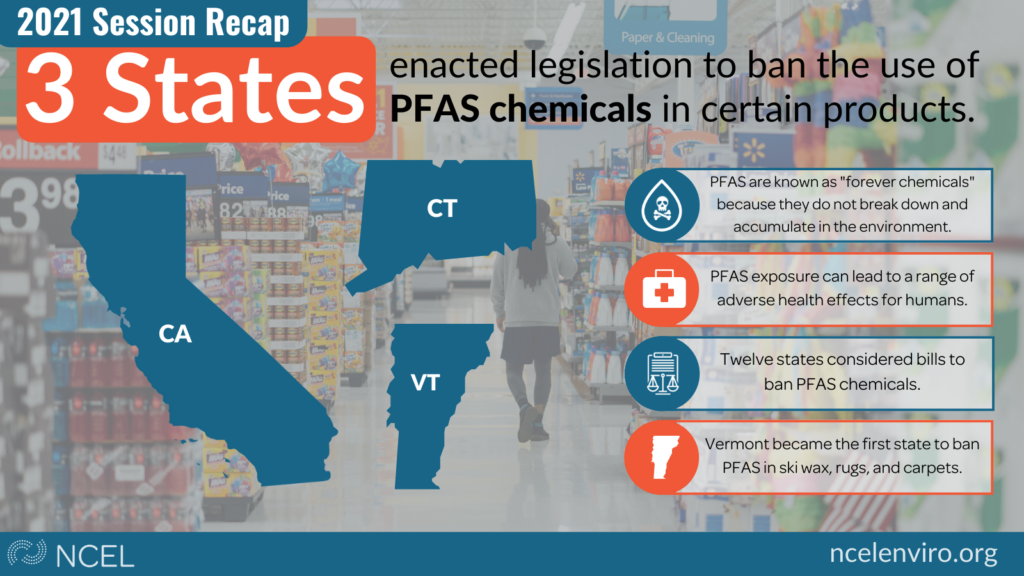
Mississippi River
The Mississippi River and watersheds throughout the United States have seen an uptick in flooding events and nutrient pollution which state legislatures have been working to remedy. Six states in the Mississippi River watershed introduced bills to expand sustainable agriculture practices which can both play a role in reducing nutrient pollution and acting as a buffer against severe flooding. Iowa advanced legislation to develop a strategy that would limit nutrient pollution into waterways. All ten states in the Mississippi River watershed took action to improve water quality. Finally, four Mississippi River states introduced legislation to increase soil health which in addition to filtering pollutants and helping to prevent flooding, helps slow rates of climate change by storing large amounts of organic carbon.
The list of legislation below is a small sampling of enacted bills in the Mississippi River region during the 2021 session. A full list of relevant legislation from this session can be found here.
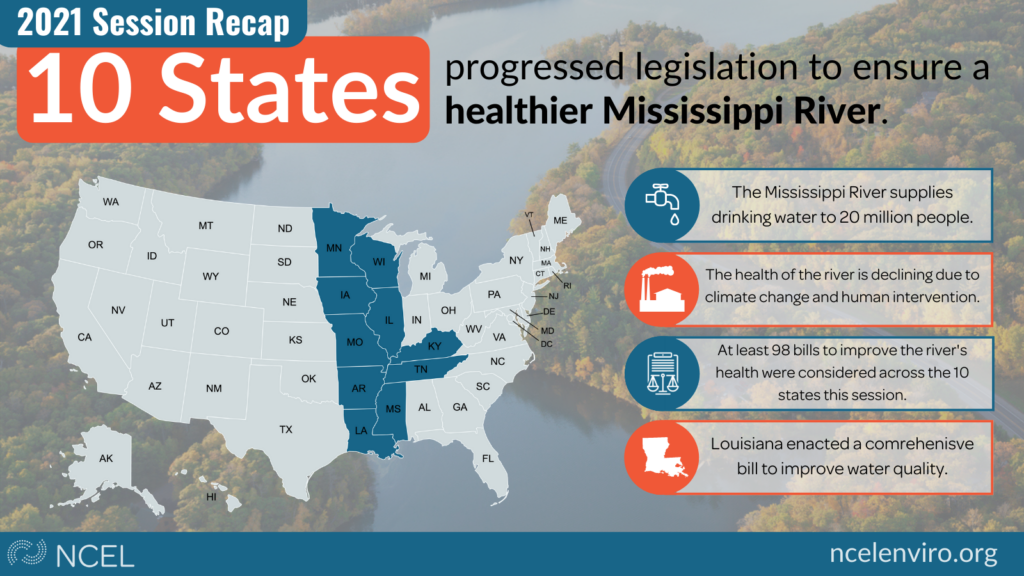
A Selection of Enacted Mississippi River Bills
- Louisiana
- (HB 622) Creates a Rural Development Fund to fund projects that will enhance the socio-economic well-being of the state’s rural areas including but not limited to improving water quality, agriculture, the environment, and land use. Also creates a state Office of Rural Development that will serve as a single contact point for rural governments, service providers, state and federal agencies, and for individuals interested in rural policies and programs of the state; and shall strive to promote cooperative and integrated efforts among such agencies and programs that are designed to address rural needs.
- (SB 129) Creates a statewide water quality monitoring and accountability system in which community water systems are rated by the Louisiana Department of Health on a letter grade scale between A and F. Communities with D and F grades must allocate 100% of their water payment revenue towards the improvement of their water systems.
- (HCR 69) Commends the work being done by Louisiana’s agricultural conservation partnerships including efforts to improve water quality and environmental health.
- Minnesota
- (HF 8) Requires the implementation of a Dairy Development andProfitability Enhancement program in which teams (made up of qualified organizations) will assist all dairy producers to enhance their financial success and long-term agricultural sustainability. Includes sustainable agriculture on-farm research and demonstration as a possible funding recipient for the state’s Agricultural Growth, Research, and Innovation program.
- (SF 20) Allocates $1.35 million over two years for districts throughout the state to adopt soil health practices.
- (HF 13) Allocates $4 million over two years for grants to farmers to adopt cover cropping and soil health practices in areas where it would directly benefit public water supplies. Up to $400,000 is allocated to the University of Minnesota’s Office for Soil Health for applied research and education on soil health.
- Tennessee (SB 1049) Mandates that a sponsor of an in-lieu fee project, under the federal Clean Water Act compensatory mitigation rule, must require legal enforcement to be taken if the sponsor fails to complete physical and biological improvements to the impacted aquatic resources by the third full growing season after the first payment.